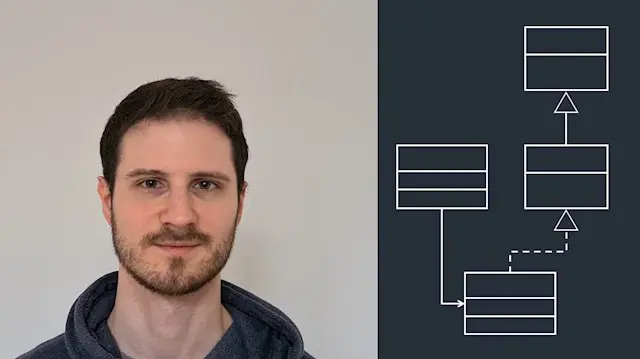
UML Class Diagrams Course
Learn how to read, model, present and use UML class diagrams using classes, attributes, methods, relations and more.
Felix Tuna
Summary
- Reed courses certificate of completion - Free
- Tutor is available to students
Add to basket or enquire
Overview
Anyone who deals with UML can hardly get around class diagrams. They are a popular tool in software modeling and probably the most widely used UML diagram. You can model classes and relations between your classes to gradually build up complete software systems. Class diagrams help you communicate your modeling approaches and present your software to your clients. They are a great tool to talk about software and what needs to be done to fulfill given requirements.
You will:
- LEARN the syntax and semantics of UML class diagrams (i.e. classes, relations and more).
- UNDERSTAND foreign and complex class diagrams.
- MODEL software requirements with UML class diagrams.
- USE design patterns to further enhance your class diagrams.
- PRESENT your own class diagrams to colleagues and clients.
- TRANSLATE software requirements into class diagrams.
- IMPLEMENT software (e.g. with Java) based on a given class diagram.
TUTOR ASSISTANCE: Every student in this online video course can easily ask questions on the video course material via e-mail. You can also send results, i.e. your own class diagrams, and get useful feedback on what you may need to improve and what is already looking great in your UML class diagram!
Certificates
Reed courses certificate of completion
Digital certificate - Included
Will be downloadable when all lectures have been completed
Curriculum
Course media
Description
UML Class Diagrams
In this course I will teach you a lot about UML class diagrams. Keep in mind, that this is not a UML complete course. I will focus on UML class diagrams completely. You will not only learn how to read and understand these diagrams, but also how to model them yourself. After this course you have everything you need to understand complex foreign class diagrams, model software systems elegantly yourself or together with your team and even present them to your clients. Of course, everything I teach requires some practice. In this course we work with a lot of examples! This course consists of six sections:
-
Introduction
This is the introduction to the course. You will get to know how the course is structured, get access to additional learning material and we directly start with an overview of UML diagrams and a first exemplary class diagram. -
Basic Concepts
In this section we will deal with basic concepts of class diagrams. You will get to know different kinds of classes and relations. After this section you will already be able to read and understand easy class diagrams and even model some small examples yourselves! -
Advanced Concepts
In this section we deal with more complex examples and concepts. We will still talk about classes and relations, but you will get information on advanced concepts to further improve your diagrams and model even more precise. -
Design Patterns
This section explains the area of application and syntax of one design pattern per video. A design pattern is a part of a class diagram made for reuse. You will learn valuable information on how and when to use each of these design patterns to enhance your class diagrams with proven solutions. -
Code Generation
How do you even write code from a class diagram? In this section I will explain to you what you need to implement for classes, attributes, methods and the different types of relations. You will see that it is even possible to generate such code automatically. -
The End
In this last video I recap what you have learned in the course. Congratulations on coming this far!
Who is this course for?
This course is for:
- Young Professionals who want to acquire expert knowledge.
- Programmers who deal with software modeling.
- (Computer Science) students preparing for a Software Engineering exam.
- Project Managers and others involved in IT projects.
- Everybody who is interested in software modeling with UML.
Requirements
Interest in software modeling.
Basic knowledge of object orientation is useful, but not necessary. In the course, you will sometimes see Java(-related) code that is explained in detail. While it is easier for you if you are familiar with Java programming language, it is not necessary to take part in this course.
Career path
Software Engineer
Software Developer
Usually, both of these positions require additional knowledge of at least one programming language and in some cases/for some companies a Bachelor or Master degree in Computer Science or similar.
Questions and answers
Currently there are no Q&As for this course. Be the first to ask a question.
Reviews
Currently there are no reviews for this course. Be the first to leave a review.
Legal information
This course is advertised on reed.co.uk by the Course Provider, whose terms and conditions apply. Purchases are made directly from the Course Provider, and as such, content and materials are supplied by the Course Provider directly. Reed is acting as agent and not reseller in relation to this course. Reed's only responsibility is to facilitate your payment for the course. It is your responsibility to review and agree to the Course Provider's terms and conditions and satisfy yourself as to the suitability of the course you intend to purchase. Reed will not have any responsibility for the content of the course and/or associated materials.


